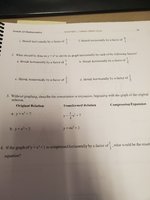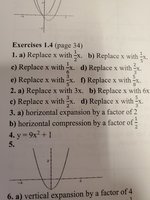First time posting here, so I'm not sure if posting "homework" questions is allowed, but I'm going to ask anyway since I cant find any answers to my questions anywhere else;
Question: Describe the compression or expansion starting with the original relation
a) y=x^2 + 7 --> y=(1/4)x^2 + 7
b) y=x^2 + 2 --> y=4x^2 + 2
My answers:
a) vertical stretch BAFO 1/4
b) vertical stretch BAFO 2 (not sure how I got this one)
but the books answer was "Horizontal expansion BAFO 2" for "a" and "horizontal compression BAFO 1/2" for "b".
What I want to know is:
- even after realizing they were making horizontal transformations, shouldn't "a" be a Horizontal expansion BAFO 4 and "b" be a Horizontal expansion BAFO 1/4 since the stretches are BAFO (1/b)?
- shouldn't the question have been formatted as ((1/4)x)^2 + 7 and (4x)^2 + 2 if it was a horizontal transformation?
Thanks in advance for the help
Question: Describe the compression or expansion starting with the original relation
a) y=x^2 + 7 --> y=(1/4)x^2 + 7
b) y=x^2 + 2 --> y=4x^2 + 2
My answers:
a) vertical stretch BAFO 1/4
b) vertical stretch BAFO 2 (not sure how I got this one)
but the books answer was "Horizontal expansion BAFO 2" for "a" and "horizontal compression BAFO 1/2" for "b".
What I want to know is:
- even after realizing they were making horizontal transformations, shouldn't "a" be a Horizontal expansion BAFO 4 and "b" be a Horizontal expansion BAFO 1/4 since the stretches are BAFO (1/b)?
- shouldn't the question have been formatted as ((1/4)x)^2 + 7 and (4x)^2 + 2 if it was a horizontal transformation?
Thanks in advance for the help


